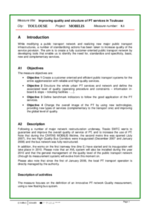Improving the quality and structure of public transport services
Thematic areas
Collective passenger transport & shared mobility
Summary
New standards were introduced to ensure the quality of public service provision and create a fully customer oriented public transport network in Toulouse.
Implementing sustainable mobility
With the public transport network being restructured, the public transport authority Tisseo saw an opportunity to improve the overall quality of the service in terms of punctuality, regularity and journey comfort. It was hoped this would result in an increase the number of public transport passengers.
Specific objectives were to:
- create a customer-oriented and efficient public transport system for the entire urban area with reliable and high-quality services;
- structure all urban public transport services according to a defined level of quality (operating procedure and constraints, on-board and stop information, ticketing facilities etc.);
- define benchmark indicators to assess public transport service quality; and
- change the overall image of public transport by using new technologies and providing new types of services in order to comply with the EN 13816 quality standard for public transport and obtain national certification.
Progress
Following local institutional changes (including the management of public transport services) in January 2006, the content of this measure evolved from a top-down approach (general objectives, implementation, impact assessment) to a bottom-up approach (assessment of indicators, analysis of service quality, inputs for the development of a strategic framework).
In order to achieve common quality standards on the public transport bus lines, Tisseo installed sensors on 44 buses in September 2007 in order to obtain comprehensive operational data for the different bus lines (journey time, passenger exchange time, waiting time at traffic lights). These data were used by a committee comprising the public transport authority and operator as well as the public transport passengers association, which was in charge of validating the work plan for the certification of selected bus lines.
In parallel, Tisseo defined a new certification methodology and action plan between January and November 2008. Measurement activities took place on several bus lines under different conditions (peak hours, off-peak hours, holidays, weekends) in order to collect complete operational data. In November 2008, Tisseo presented the data to the national standardisation authority and certification body.
Outcomes
The decision to postpone the reorganisation of the public transport network after the opening of the second metro line and the political conflicts hindered measure implementation. Nevertheless, the automatic measurement of service quality and public transport service certification were shown to help the public transport system to achieve the desired quality and standards. Beyond the measure implementation period, Tisseo will continue to draw benefits from the “floating bus” measurement tool by carrying out continuous assessment of the quality of different bus lines in the network, leading to more certified bus lines.








